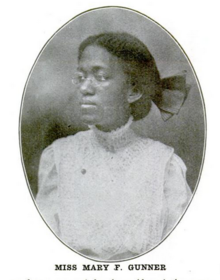Mary Frances Gunner
Mary Frances Gunner | |
|---|---|
 Mary Frances Gunner, from the 1915 yearbook of Howard University | |
| Born | Mary Frances Gunner Lexington, Kentucky, U.S. |
| Occupation | Playwright |
| Alma mater | Howard University |
| Notable works | Light of the Women (1924) |
| Spouse | Jerry van Dunk |
| Relatives | Byron Gunner (father) |
Mary Frances Gunner (November 9, 1894 – May 13, 1953) was an African American playwright and community leader based in Brooklyn, New York. She was also known as Francis Gunner Van Dunk.[1]
Early life and education

Mary Frances Gunner was born in Lexington, Kentucky and raised in Hillburn, New York, the daughter of Rev. Byron Gunner and Cicely Savery Gunner. Her parents, both born in Alabama,[2] were active in public life; her father was one of the 29 founders of the Niagara Movement and president of the National Equal Rights League, and her mother, a teacher, was president of the Empire State Federation of Women's Clubs.[3] Her grandfather William Savery, born a slave, was a founder of Talladega College.[4]
She finished at Suffern High School as the only black girl in her class, and as valedictorian.[5] She attended Middlebury College.[6] She also attended Howard University, and was an officer in that school's chapter of the National Association for the Advancement of Colored People.[7] In 1913, she was initiated into Delta Sigma Theta sorority. She served as President of Alpha Chapter from 1914-1915.[8] In her capacity as President, she requested that Mary Church Terrell write the Sorority's Oath. In 1923, she completed a master's degree in the Political Science department at Columbia University, with a thesis titled "Employment Problems Among Negro Women in Brooklyn."[9]
Career
Mary Frances Gunner worked at the YWCA in Montclair, New Jersey, and after 1921[10] at the Ashland Place YWCA[11] in Brooklyn.[12] She also taught school in New York.[13] Gunner was a branch manager for the New York State Employment Service from 1938 to 1950.[14] She was active in the National Association of College Women.[15]
Her pageant play, Light of the Women (1924), presents the stories of such African-American heroines as Sojourner Truth, Harriet Tubman, Fanny Jackson Coppin, and Phillis Wheatley. It was intended for performance by community groups and schools,[16] to teach and celebrate the achievements of African-American women.[17] It was performed in 1927 at the YWCA in Orange, New Jersey.[18]
Personal life
Mary Frances Gunner married Jerry van Dunk, also from Hillburn, in 1946.[19] She died in Brooklyn in 1953.[20]
References
- ^ "Van Dunk, Frances Gunner". Notable Kentucky African Americans Database, University of Kentucky Libraries. Retrieved 2023-05-22.
- ^ Angela Jones, African American Civil Rights: Early Activism and the Niagara Movement (ABC-Clio 2011): 220. ISBN 9780313393600
- ^ "Hillburn, N. Y." New York Age (July 24, 1943): 9. via Newspapers.com

- ^ Sallie L. Powell, "Byron Gunner", in Gerald L. Smith, Karen Cotton McDaniel, and John A. Hardin, eds., The Kentucky African American Encyclopedia (University Press of Kentucky 2015): 219-220. ISBN 9780813160665
- ^ "Miss Mary Frances Gunner" The Crisis (October 1911): 235-236.
- ^ Middlebury College, "Students", Catalogue (1915): 133.
- ^ Howard University Yearbooks, The Mirror (1915): 39.
- ^ Howard University, The Mirror (1915 yearbook): 39.
- ^ Sallie L. Powell, "Mary Frances Gunner", in Gerald L. Smith, Karen Cotton McDaniel, and John A. Hardin, eds., The Kentucky African American Encyclopedia (University Press of Kentucky 2015): 220. ISBN 9780813160665
- ^ "Ashland Branch Y to Have New Secretary" New York Age (September 10, 1921): 8. via Newspapers.com

- ^ "Whites Kinder in Attitude Towards Negroes is Claim; Frances Gunner, Colored Secretary of YWCA, Sees Improved Race Relations" Bridgeport Telegram (February 13, 1928): 3. via Newspapers.com

- ^ Bernard L. Peterson, ed., Early Black American Playwrights and Dramatic Writers (Greenwood Publishing 1990): 93. ISBN 9780313266218
- ^ Catalogue of Officers and Students of Middlebury College (Middlebury College 1917): 453.
- ^ "Servants Scarce and Expensive As Result of Wartime Pay Rates" Brooklyn Daily Eagle (June 23, 1946): 10. via Newspapers.com

- ^ Linda M. Perkins, "The National Association of College Women: Vanguard of Black Women's Leadership and Education, 1923-1954" Journal of Education 172(3)(1990): 68.
- ^ Lurana Donnels O'Malley, "Spirits in Black and White: Ethiopia as the Black Columbia in African American Pageantry" in Graley Herren, ed. Text & Presentation 2015 (MacFarland 2016): 144-146. ISBN 9781476624730
- ^ Willis Richardson, ed., Plays and Pageants from the Life of the Negro (University Press of Mississippi 1993): 333-342. ISBN 9781617034565
- ^ "Orange, N. J." Pittsburgh Courier (May 7, 1927): 9. via Newspapers.com

- ^ "Frances Gunner Weds Jerry Van Dunk on Fri. By Rev. Stark" New York Age (February 16, 1946): 7. via Newspapers.com

- ^ "Ramapo Valley Independent 3 June 1954 — HRVH Historical Newspapers".
